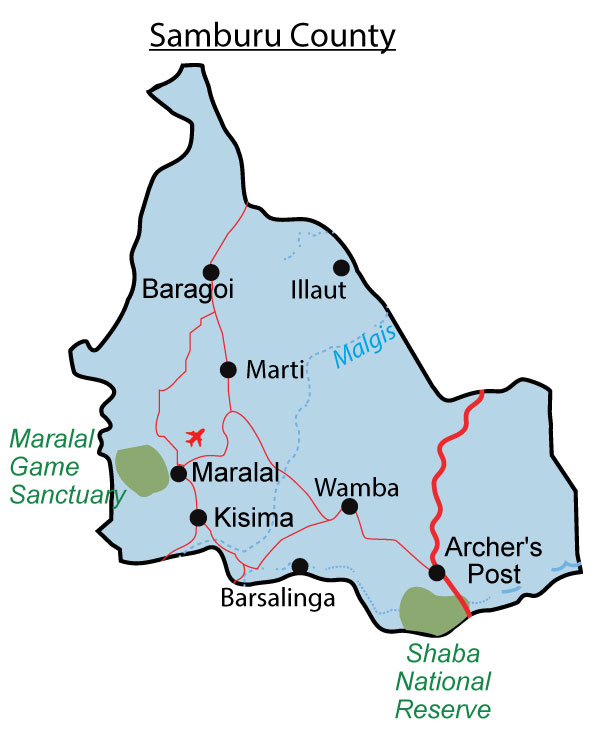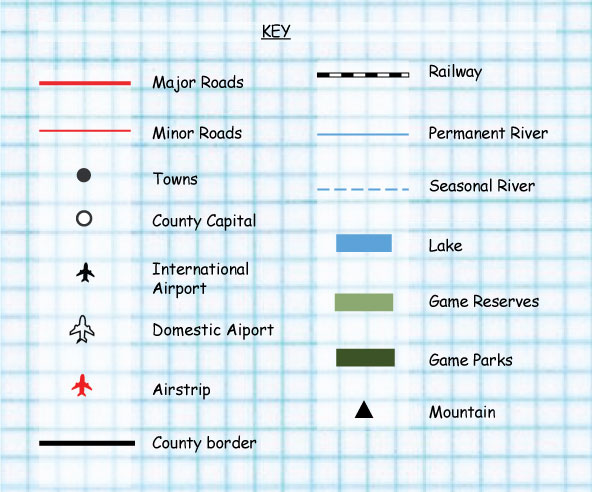Samburu County
Introduction
- Is a county in the former Rift Valley Province, Kenya.
- It covers an area of roughly 21, 000 km² (8, 000 mi²) in northern Kenya where the Samburu, Turkana and many other tribes live.
- It stretches north from the Wuaso Ng'iro River to the south of Lake Turkana and also includes Mount Kulal which lies just east of Lake Turkana.
Within Samburu County are the towns of Maralal (capital and largest town), Baragoi, Archers Post, South Horr, Wamba and Lodosoit.

Constituencies
- Samburu West
- Samburu North
- Samburu East.
Main physical features
Rivers
- Ewaso Ng'iro river
- Lembarass River
- Lengusaka River
Mountains
- Mount Ng'iro
- Ndoro Mountains
- Mathews Range (Ol Doinyo Lenkiyo)
Hills
Plains
Valleys
Importance of physical features
- The attract tourist hence a source of income to the county government.
- The forest is a natural habitat to animals and birds
- Mountain tops and forests were used as sacred places for worship
Types of natural vegetation
- Forest vegetation
- Semi-Arid vegetation
Importance of the vegetation
- Vegetation contribute to the climate of the region
- It provides a natural habitat for plants birds and animals
Map of distribution of the physical features.


People and population
Language groups
- The Samburu are the main language group.
Areas of high population density
- Maralal town
- Wamba town
- Lodosoit town
Areas of low population density
Social relations and cultural activities
Traditional way of life of the people
Food
- The Samburu are highly dependent on their livestock for survival. Their diet comprises mostly of milk and occasionally blood from their cows.
Dressing
- Samburu traditional dress is a striking red cloth wrapped around like a skirt (called Shukkas) and a white sash. This is enhanced with many colorful beaded necklaces, earrings and bracelets. Both men and women wear jewelry although only the women make it. The Samburu also paint their faces using striking patterns to accentuate their facial features. Neighboring tribes, admiring the beauty of the Samburu people, called them samburu which in fact means "butterfly". The Samburu referred to themselves as the Loikop.
Songs and dances
- Dancing is very important in the Samburu culture. Dances are similar to that of the Maasai with men dancing in a circle and jumping very high from a standing position. The Samburu have traditionally not used any instruments to accompany their singing and dancing. Men and women do not dance in the same circles, but they do coordinate their dances.
Traditional medical practices
- They had special healers specifically for this job who went to gather herbs for healing.
Ceremonies and festivals held
Ceremonies
- Birth of a new born was followed by a thanks giving celebration.
- Naming was done depending on the season and circumstance. Children born at night were named differently with children born at night. Children born during drought were named differently with children named during harvest.
- Circumcision for both boys and girls is one of the most important rituals among the Samburu.
- For boys, circumcision marks the initiation into Moran (warrior) life; for girls, it signifies becoming a woman.
- Once circumcised, a girl/woman can be given away in an arranged marriage to start her own family. Sadly, this practice has seen girls as young as 12 years old get married to men old enough to be their grandfathers.
Festivals
Resources and economic activities
Agriculture
Main cash crops and food crops grown
- Maize
- Carrots
- Peas
- Potatoes
- Wheat
The areas where the cash crops are grown
- Maralal
- Wamba
- Lodosoit
- Kauro
Types of livestock kept
Fishing
Areas where fishing is practiced
- Ewaso Ng'iro river
- Lembarass River
- Lengusaka River
Forestry
Major forests
Wildlife and Tourism
Types wildlife
- Elephants
- Grevy's zebra
- Oryx and reticulated giraffe.
The game parks and reserves
- Samburu National Reserve
- Bisanadi National Reserve
- Buffalo Springs National Reserve
Major tourist attractions
- Shaba National Game Reserve
- Buffalo Springs National Reserve
- Samburu National Reserve
- Bisanadi National Reserve
- Buffalo Springs National Reserve
Industries
Traditional industries and the products
- Farming
- Herding
- Gathering and hunting
Trade
The major trading centers
- Maralal
- Wamba town
- Lodosoit town
- Archers post


